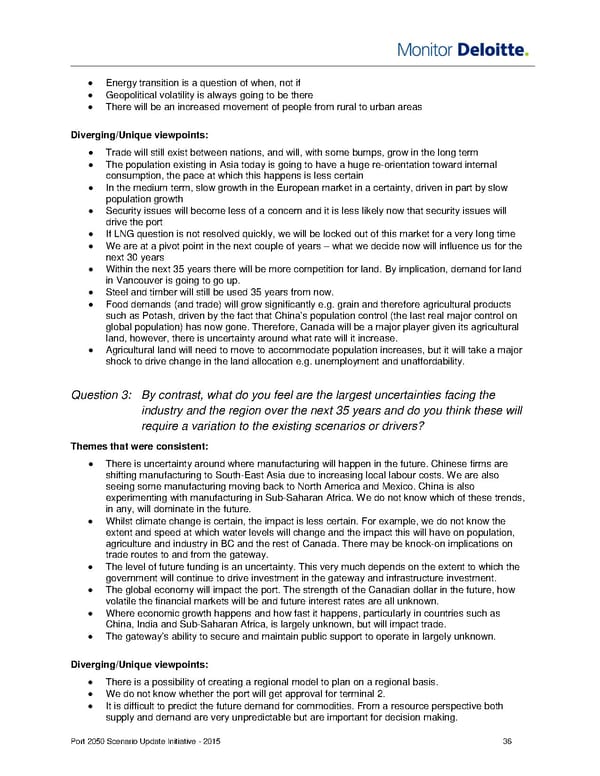• Energy transition is a question of when, not if • Geopolitical volatility is always going to be there • There will be an increased movement of people from rural to urban areas Diverging/Unique viewpoints: • Trade will still exist between nations, and will, with some bumps, grow in the long term • The population existing in Asia today is going to have a huge re-orientation toward internal consumption, the pace at which this happens is less certain • In the medium term, slow growth in the European market in a certainty, driven in part by slow population growth • Security issues will become less of a concern and it is less likely now that security issues will drive the port • If LNG question is not resolved quickly, we will be locked out of this market for a very long time • We are at a pivot point in the next couple of years – what we decide now will influence us for the next 30 years • Within the next 35 years there will be more competition for land. By implication, demand for land in Vancouver is going to go up. • Steel and timber will still be used 35 years from now. • Food demands (and trade) will grow significantly e.g. grain and therefore agricultural products such as Potash, driven by the fact that China’s population control (the last real major control on global population) has now gone. Therefore, Canada will be a major player given its agricultural land, however, there is uncertainty around what rate will it increase. • Agricultural land will need to move to accommodate population increases, but it will take a major shock to drive change in the land allocation e.g. unemployment and unaffordability. Question 3: By contrast, what do you feel are the largest uncertainties facing the industry and the region over the next 35 years and do you think these will require a variation to the existing scenarios or drivers? Themes that were consistent: • There is uncertainty around where manufacturing will happen in the future. Chinese firms are shifting manufacturing to South-East Asia due to increasing local labour costs. We are also seeing some manufacturing moving back to North America and Mexico. China is also experimenting with manufacturing in Sub-Saharan Africa. We do not know which of these trends, in any, will dominate in the future. • Whilst climate change is certain, the impact is less certain. For example, we do not know the extent and speed at which water levels will change and the impact this will have on population, agriculture and industry in BC and the rest of Canada. There may be knock-on implications on trade routes to and from the gateway. • The level of future funding is an uncertainty. This very much depends on the extent to which the government will continue to drive investment in the gateway and infrastructure investment. • The global economy will impact the port. The strength of the Canadian dollar in the future, how volatile the financial markets will be and future interest rates are all unknown. • Where economic growth happens and how fast it happens, particularly in countries such as China, India and Sub-Saharan Africa, is largely unknown, but will impact trade. • The gateway’s ability to secure and maintain public support to operate in largely unknown. Diverging/Unique viewpoints: • There is a possibility of creating a regional model to plan on a regional basis. • We do not know whether the port will get approval for terminal 2. • It is difficult to predict the future demand for commodities. From a resource perspective both supply and demand are very unpredictable but are important for decision making. Port 2050 Scenario Update Initiative - 2015 36
 Monitor Deloitte - Final Report Page 37 Page 39
Monitor Deloitte - Final Report Page 37 Page 39